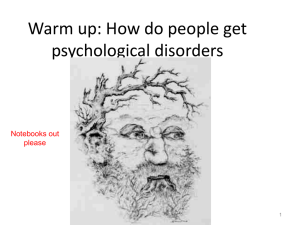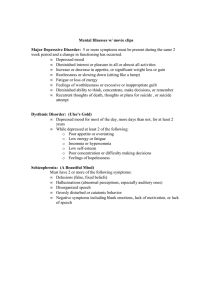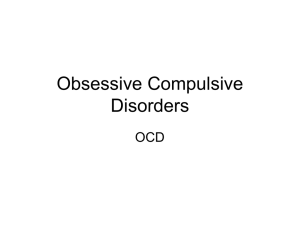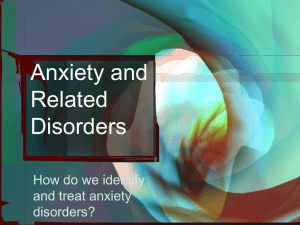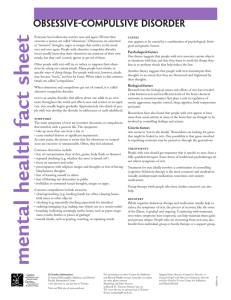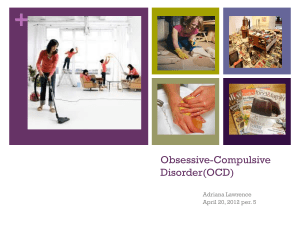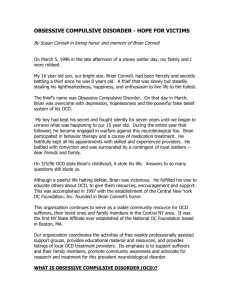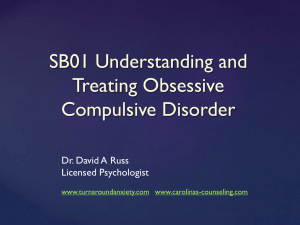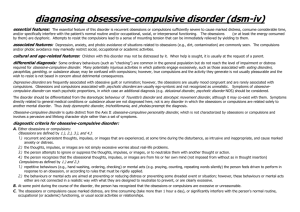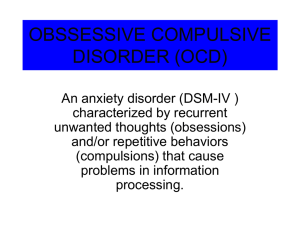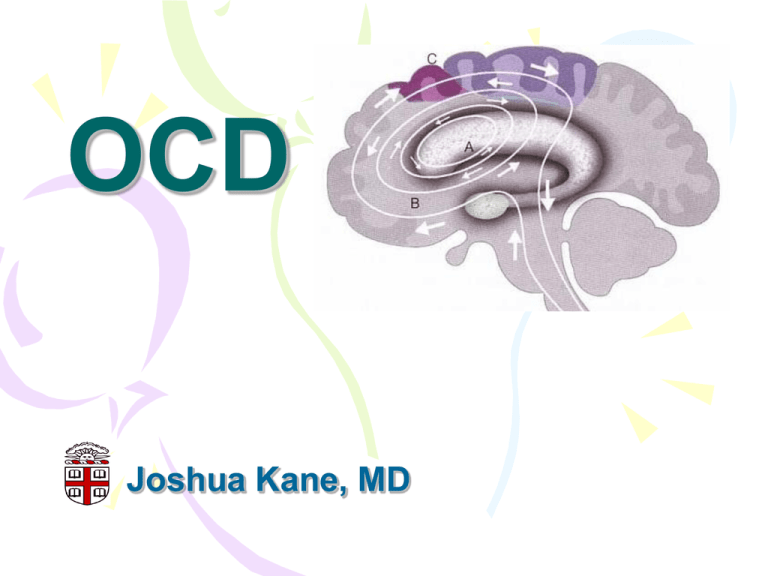
OCD
Joshua Kane, MD
What is OCD?
• DSM-IV TR Criteria:
•
•
•
A. Either obsessions or compulsions:
Obsessions as defined by (1), (2), (3), and (4):
(1) recurrent and persistent thoughts, impulses, or images that are experienced at some time
during the disturbance, as intrusive and inappropriate and that cause marked anxiety or distress
•
(2) the thoughts, impulses, or images are not simply excessive worries about real-life problems
•
(3) the person attempts to ignore or suppress such thoughts, impulses, or images, or to neutralize
them with some other thought or action
•
(4) the person recognizes that the obsessional thoughts, impulses, or images are a product of his
or her own mind (not imposed from without as in thought insertion)
DSM-IV-TR Criteria (cont.)
•
•
•
•
•
•
•
•
Compulsions as defined by (1) and (2):
(1) repetitive behaviors (e.g., hand washing, ordering, checking) or mental acts (e.g., praying, counting, repeating
words silently) that the person feels driven to perform in response to an obsession, or according to rules that must
be applied rigidly
(2) the behaviors or mental acts are aimed at preventing or reducing distress or preventing some dreaded event or
situation; however, these behaviors or mental acts either are not connected in a realistic way with what they are
designed to neutralize or prevent or are clearly excessive
B. At some point during the course of the disorder, the person has recognized that the obsessions or compulsions
are excessive or unreasonable. Note: This does not apply to children
C. The obsessions or compulsions cause marked distress, are time consuming (take more than 1 hour a day), or
significantly interfere with the person’s normal routine, occupational (or academic) functioning, or usual social
activities or relationships.
D. If another Axis I disorder is present, the content of the obsessions or compulsions is not restricted to it (e.g.,
preoccupation with food in the presence of an Eating Disorder; hair pulling in the presence of Trichotillomania;
concern with appearance in the presence of Body Dysmorphic Disorder; preoccupation with drugs in the presence
of a Substance Use Disorder; preoccupation with having a serious illness in the presence of Hypochondriasis;
preoccupation with sexual urges or fantasies in the presence of a Paraphilia; or guilty ruminations in the presence
of Major Depressive Disorder).
E. The disturbance is not due to the direct physiological effects of a substance (e.g., a drug of abuse, a
medication) or a general medical condition.
Specify if:
– With poor insight: if, for most of the time during the current episode, the person does not recognize that the
obsessions and compulsions are excessive or unreasonable.
Obsessions
• Obsessions are intrusive, distressing thoughts
and mental images which repeat over and over.
They are ego-dystonic (experienced as
unpleasant).
• Common obsessions:
–
–
–
–
–
–
–
Dirt and contamination
Need for symmetry
Hoarding
Sexual content
Scrupulosity
Aggressive content
Superstitious fears
Compulsions
• Compulsions are behaviors people perform in
order to try and reduce or remove the fear and
anxiety caused by obsessions.
• Common compulsions:
–
–
–
–
–
Cleaning and washing
Arranging until things are “just right”
Hoarding
Checking
Mental rituals (prayers, counting etc.)
OCPD
• Pervasive pattern of preoccupation with
orderliness, perfectionism, and mental and
interpersonal control, at the expense of flexibility,
openness and efficiency.
• Preoccupation with details, rules and lists, so
that the point of the activity is lost
• Perfectionism that interferes with task
completion
• Excessively devoted to work so that leisure
activities and friendships suffer
OCD vs. OCPD
• OCD is ego dystonic, personality disorders
are ego syntonic
• OCPD lacks true obsessions or
compulsions
• OCD patients are found in clinics, people
with OCPD go to med school
QuickTime™ and a
TIFF (LZW) decompressor
are needed to see this picture.
Epidemiology
The lifetime prevalence of OCD is between 2 and
3%. Child/adolescent prevalence is 1-2.3%.
There is similar epidemiology among diverse cultures
(studies in Europe, Asia and Africa have confirmed
rates).
In adults, male and female prevalence is the same. In
children and adolescents, males are more likely than
females to be affected.
Epidemiology II
• Mean age of onset is approximately 20
years old (males with mean around 19 and
females around 22).
• Two-thirds of affected people have onset
before age 25. Less than 15% have onset
after age 35.
• OCD occurs less often among blacks than
whites in the US, but access to health care
may be a confounding variable.
OCD Etiology
Biological
Psychological
Social
Serotonin hypothesis
Psychodynamic
Accomodation
Brain Imaging
Personality
Adaptive mechanisms
Genetics
Behavioral
Neuroimmunologoy
Biological
Serotonin Hypothesis
Clomipramine, SSRI’s, mCPP
Neuroimmunology
PANDAS, autoimmune
Genetics
1st degree relatives 35%, Monozygotes 80-87%
Neuroimaging
Orbital Frontal Cortex, Basal Ganglia, Anterior Cingulate Gyrus
Psychological
• Psychodynamic Theory
– Regression to anal phase, poor treatment response
• Personality (Axis I vs. Axis II)
– Approx 25% of OCD have OCPD
• Accomodation
– “enabling” model from addictions
• Social Isolation
– Lower rates of marriage, group therapy
Screening Questions
• Why Screen?
– Lag time from onset to diagnosis, shame
• Do you have repetitive thoughts that make you
anxious and that you can’t get rid of no matter
how hard you try?
• Do you keep things extremely clean or wash
your hands frequently?
• Do you check things to excess?
• Check for comorbidity
– Lifetime MDD in adults is 2/3. OCD often precedes
MDD in kids and adults
“Brain Lock”
• Orbitofrontal Cortex- the error detector
– Functions of the superego are implemented by OFCamygdala circuitry
– Evolved to temper pursuit of pleasure (limbic system)
with consideration of context and risk
• Basal Ganglia
– caudate: the “thought gear shift”
• Anterior Cingulate- gut feelings
– Appropriate response to internal and external stimuli
– Projects to autonomic, visceromotor and endocrine
systems
QuickTime™ and a
TIFF (LZW) decompressor
are needed to see this picture.
Treatment
•
•
•
•
Pharmacotherapy
Cognitive-Behavioral Therapy
Psychosurgery
Deep Brain Stimulation
Pharmacotherapy
• SSRI’s
– First line, no major difference in class
– Higher doses than for MDD (ex. 80 mg fluoxetine)
– 10-12 weeks before switching
• Clomipramine
– first FDA approved, most serotonin specific of TCA’s,
side effects
– Augmentation, no to Li, atypical antipsychotics, e.g.
risperidone (5HT2A blockade suggests there’s more
to it than just “low serotonin”)
Psychotherapy
• Psychodynamic therapy: low efficacy
• Cognitive-Behavioral Therapy
– RCT supported
– Longer lasting than pills
– Cognitive
• Challenge faulty reasoning
• Ex: “magical thinking”
– Behavioral
• Exposure and Response Prevention
– List of things that make you go “ugh!” in rank order
– Loop tapes for the pure obsessionals
– Caveats
• Drop out rates significant, shoot for 12-20 sessions
Shameless Plug
• Brain Lock, by Jeffrey Schwartz
• The Four Steps
– Relabel
– Reattribute
– Refocus
– Revalue
Treatment Refractory
• Psychosurgery
– For patient’s who have failed meds and therapy
– Response rate approx. 50%
– Four surgical prodecures
• Cingulotomy, subcaudate tractotomy, limbic leukotomy,
capsulotomy
• Interrupt signals from OFC to basal ganglia
– Gamma Knife
• Anterior limb of internal capsule
Prognosis
• Chronic waxing and waning
• Treatment lag decreasing
– OCF, ‘Monk’
• The rule of thirds
– 20-30% “significant improvement”
– 40-50% “moderate improvement”
– Remaining 20-40% stay ill or get worse
You down with OCD?
• The biology is interesting and still being
investigated
• It’s pills vs. talk, and talk wins!
• It’s the yale-BROWN-obsessive
compulsive scale (thank you Drs.
Rasmussen and Eisen)
• Most patients get better with treatment

